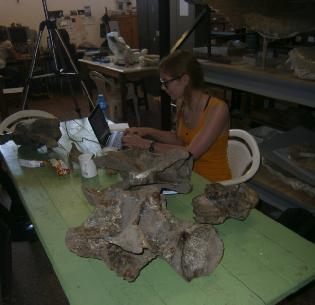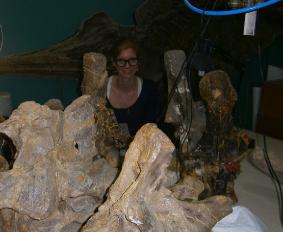MSc. Femke Holwerda
Bayerische Staatssammlung für Paläontologie und Geologie
Richard-Wagner-Strasse 10
80333 Munich
Germany
Telephone: +49 89 2180 6619
Biography
2013: PhD student in DFG project: Revision of basal sauropods from the Middle Jurassic of Patagonia and the early evolution of eusauropods. Supervisors: Dr. Oliver Rauhut and Dr. Diego Pol.
2012-2013: Universidade Nova de Lisboa, FCT research fellow in Project Dinoeggs: Dinosaur eggs and embryos from Portugal: paleobiological and paleoenvironmental implications. Supervisor: Prof. Dr. Octávio Mateus.
2011: Research Assistant at Durham University, Faculty of Earth Sciences, SIBL, Ocean Anoxic Events. Supervisor: Dr. Darren Gröcke.
2011: MSc project Utrecht University 'Sea level changes across the K-Pg Boundary'. Supervisor: prof. dr. Henk Brinkhuis.
2010: MSc project Utrecht University and MEF Trelew, Argentina: 'Middle Jurassic basal sauropod teeth from Patagonia, Argentina'. Supervisors: Dr. Diego Pol and Dr. Oliver Rauhut.
Research Interests
Jurassic sauropods – Jurassic archosaur eggs – archosaur tooth microwear and tooth morphology – applied biogeochemistry

My main research interest is sauropods, in particular Gondwanan eusauropods. For my PhD, cranial and postcranial material from Patagosaurus, a sauropod from the early Middle Jurassic of Patagonia, Argentina will be redescribed, in order to clarify the early evolution and radiation of eusauropods. I went to Tucumán, Buenos Aires and Trelew in Argentina to study the holotype and other referred material of Patagosaurus. A few more trips are necessary (certainly no punishment) but I can start redescribing the holotype now.
My further research interests include archosaur dental macro- and microwear and tooth morphology. Tooth microwear together with tooth and cranial morphology can help determine the feeding habits and diet of extinct animals. This has recently been applied to study the durophagous mosasaur Carinodens, and soon will be further applied to study other possibly durophagous extinct animals, such as placodonts. This project will be in collaboration with Jelle Reumer (Utrecht University, Natural History Museum Rotterdam) and Anne Schulp (Naturalis Leiden, VU Amsterdam, Natural History Museum Maastricht).

Tooth morphotypes can also be used to estimate taxonomic diversity from a locality. This was used in my MSc project to help determine sauropod species diversity at Cerro Cóndor, Argentina, as well as attempting to assign isolated teeth to sauropod species. I’m currently finishing a paper on this together with my supervisors Diego Pol and Oliver Rauhut, so more on that soon!
I also have a palynological and biogeochemical background, which kept me interested in applying biogeochemistry in paleontology using, for instance, isotopes.
Scientific works
2. Ribeiro, V., Mateus, O., Holwerda, F., Araujo, R., Castanhinha,R. 2014. Two new theropod egg sites from the Late Jurassic Lourinha Formation, Portugal. Historical Biology 26: 206-217.
1. Holwerda, F., Beatty, B.L., Schulp, S. 2013. Dental macro- and microwear in Carinodens belgicus, a small mosasaur from the type Maastrichtian. Netherlands Journal of Geosciences 92: 267-274.

